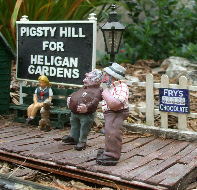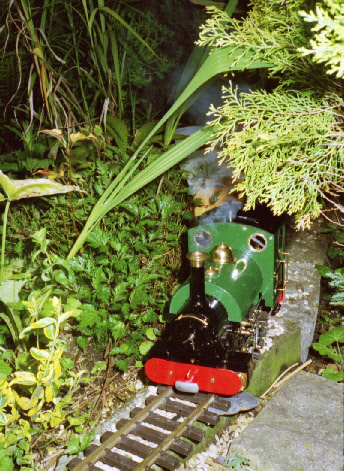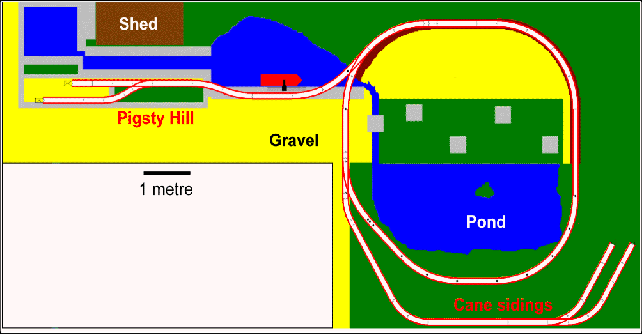
Inspiration
Five years had passed since the demise of the Pigsty Hill Light Railway. I had done
very nicely in five years of self-
I leapt in and bought the set and enough extra plastic track to resurrect the P.H.L.R.
The track-
Although the locomotive gave the appearance of "Disney meets the Deutsche Reichsbahn"
it simply un-
Anglification
The next task was to look for a prototype. I was determined to have British prototype locomotives and stock, but the garden had changed since the days of the Pigsty Hill Light Railway. The theme now was bamboos and ferns, giving a more tropical feel to things (if you can imagine tropical scenes that get no sun for three months of the year). As always when seeking inspiration, I went back to "The Narrow Gauge", the magazine of the Narrow Gauge Railway Society. It was, oddly enough, a reproduction of an advertisement for Fowler's sugar cane wagons that put me on the right track.
I already had a Fowler diesel locomotive body which would marry nicely with the Playmobil chassis, and my coaches and vans, suitably regauged, would look right in this context. LGB do a very nice line in Feldbahn (light railway) cane wagons, which would do until I could build my own to Fowler's pattern.
While surfing the Internet, I came across the remarkable fact that the Trangkil sugar
mill in Java not only operates steam locomotives, like many of its neighbours, but
that the star of the show is a small Hunslet 0-
This seemed enough justification for a sugar-

Realisation
Then, via an Internet link from a US G-
On talking to Michael Adamson of Garden Railway Specialists, I discovered that he
had also seen the potential of the Playmobil RC chassis, and that this would be an
alternative to the Lehmann 2-
Personally, I'm not too happy with large scale electric locomotives with a steam outline, although Garden Railway Specialists' fireless locomotive body would be an intriguing compromise. I suspect it relates to childhood visits to miniature "steam" railways which turned out to be nothing of the kind Also, as I suggested in my previous article, I have an increasing interest in NG and industrial diesels, which have the character and individuality so lacking in their mainline brethren. For me, the coming of the "Warships" to Bristol simply meant the demise of steam.
Implementation
As an incorrigible cheapskate, it occurred to me that, given a small line that could
happily be worked by a single locomotive, I needed only one chassis. I could combine
it with whatever drop-
Which is where I find myself now. I have one British-
I have laid down LGB track, which looks superb. To my eye it conveys an impression
of solidity which more than makes up for the brass rail. The Playmobil track which
it replaced now graces my workroom as a test-
Illumination
There are few advantages to starting a garden railway in the deep midwinter, but one of them arises from the long hours of darkness. If a railway is to run outside working hours, it has to be properly lit. Since I'm not using the track for traction power, it is the ideal means of distributing power for station and signal lights and for carriage lighting. I surprised myself by remembering how to build current pickups for the carriage wheels, and am lighting all my coaching stock as I convert the gauge. Whenever I've built railways in the summer this has always been left for 'later on' which in practice usually means never. One the unfortunate aspects of preserved railways is that they rarely operate at night, in my view a particularly magical spectacle, but this needn't be an obstacle to the garden railwayman.
Incidentally, the station buildings are from the 'Much Nattering' set (see bottom of page). Just to show how one can get it wrong, I was just working out how to fit the booking office chimney when it occurred to me that coal fires are rare in the tropics!
Evaporation
I have decided to once again go for radio-
Which I can do now; 'Hedgehog', as I've named her, is at least as controllable as my battery R/C mechanism, and is a delight to see and to run.
A clip-
Modification
As noted above, I'm gradually converting my stock to 45mm gauge, and adding illumination.
In fact the passenger brake van has been converted into a push-
All I've done on 'Hedgehog' is to change the couplings and add a cowcatcher and headlamp. It would take a braver man than me to make more than cosmetic changes to a grand's worth of engineering excellence from Roundhouse!
Justification
The line is loosely based on British colonial practice, with the North Borneo Railway as a very vague inspiration. The PHLR was initially laid to two foot gauge and connected the cane fields to the harbour at Beaufort. When the main line reached Beaufort the line was regauged to metre gauge and a passenger service provided between Pigsty Hill and Beaufort to connect with the main line service to Jesselton (now Kota Kinabalu).
Operation
A timetable is under preparation allowing for a passenger service between Pigsty Hill and Beaufort and sugar cane trains between Pigsty Hill and the cane fields.
The points on the main circuit are LGB Radius 3 (4 foot) and those at Pigsty Hill
and the cane sidings are R1 (2 foot). The point mechanisms have been swapped over
so that the manual (spring loaded) controls on the main line allow the road to remain
set in the directions of Pigsty Hill and the cane fields. This allows hands-
Big (and I mean BIG) videos of the PHLR Mark II:
PHLR II video part 1 PHLR II video part 2
For images from this period see:
The PHLR Mark III -
The Pigsty Hill Light Railway -
Rebirth of a Railway
or
Getting There Slowly









